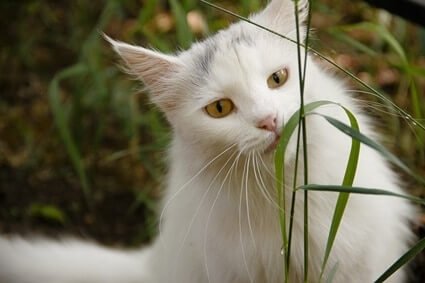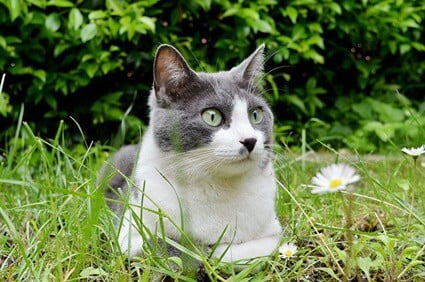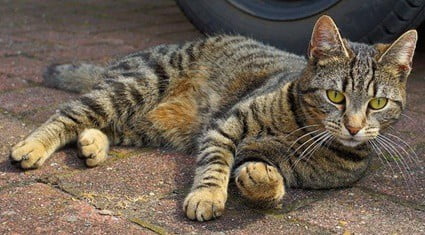The condition of a cat’s fur reflects its health. Cats constantly groom their fur and will have soft, clean, and shiny coats. However, for a variety of reasons, lighter-colored and white cats can get yellow fur.
Yellow cat fur can be due to a build-up of dirt, grease, and grime. This happens when a cat can no longer groom itself due to physical limitations, such as obesity or arthritis. A cat’s fur can turn yellow due to urine staining, food coloring, pollen, and cat litter. Also, health conditions, such as jaundice can make a cat’s fur look yellow.
In certain situations, it will be necessary to bathe your cat. Senior cats with stiff joints may not be able to reach the yellow fur on their extremities. Over time, your cat’s fur will gradually start to turn yellow and discolored.
Yellowing Cat Fur Reasons
More often than not, a cat’s white fur turning yellow is nothing to worry about. As stated, yellowed fur is often caused by dirt and grime.
Usually, your cat can easily clean the spot itself. In the case of tougher stains, a quick wash can remove the discolored fur. Here are some of the common reasons why a cat’s fur is going yellow:
Food Coloring
Cat food has added colorings, both natural and artificial. When eaten, this coloring may get on your cat’s fur, resulting in discoloration.
This doesn’t just happen in cat food that looks yellow. Even food that looks orange or red can appear yellow on the fur of a cat. However, this is more likely to happen with dry cat food.
Cat Litter
The coloring in your cat’s litter may be the reason for the stain on your cat’s fur. A litter with corn in its ingredients may have natural yellow coloring. The yellow pigment present in corn can be the reason for the issue.

Medication
Medication may have yellow coloring added to its ingredients. This is most common in flea medications, which are applied directly to the fur.
Oral medications can also get onto the fur. This happens as a cat grooms itself with saliva. Much like litter and food coloring, stains from medication are often groomed into the fur by a cat and are nothing to worry about.
Pollen
Pollen can turn a cat coat yellow but can easily be cleaned off. However, some types of pollen can be toxic to cats. According to Topics in Companion Animal Medicine, this includes lily pollen, which can harm a cat’s liver.
Urine Stains
Urine stains are often caused by being unable to use a litter box and medical conditions. If you notice your cat’s fur is regularly stained with urine, then check for other symptoms of poor health.
Inability To Clean
Sometimes, cats are unable to reach parts of their body. Perhaps your cat is carrying too much weight, or a limb has been amputated.
Some cats have a medical disorder that limits their mobility, such as stiff and painful joints. This will stop your cat from cleaning certain areas of its fur. If so, you will need to take care of your cat’s grooming.
Age
All cats will experience depigmentation as they grow older. In white cats, this can appear as yellowed fur.
How to Clean a Cat’s Yellow Fur
There are times when you should take over your cat’s grooming. Here are the steps on how to bathe a cat:
- Bath preparation: Place a bath towel at the bottom of your sink or tub. Fill the container with about 3 inches of warm water.
- Place cat in water: Hold your cat with one hand under its belly. With your other hand, hold your cat’s front paws and lower your cat.
- Wet cat’s fur: Use a hand-held spray to rinse out your cat’s fur.
- Shampoo: Use one part of cat shampoo and rub it into your cat’s fur.
- Drain: Remove the water from the fur using a stroking motion.
- Drying: Pat your cat dry with a towel and blow-dry on a low setting.
How To Remove Yellow Stains from Cat Fur
White fur stains more easily than other fur colors. Stains that have set in cat fur cannot be removed by bathing alone. If stains remain after bathing a cat, then do the following:
- Make a paste: Mix cornstarch and 3% hydrogen peroxide solution.
- Add the paste to the coat: Using an old toothbrush, add it to the coat in a circular motion. Make sure that you cover the entire stain.
- Let it sink in: Leave the paste on the coat for 15 minutes. Cover the area with a cloth to prevent your cat from ingesting the paste.
- Brush: Using a slicker brush, remove as much of the paste as you can.
- Rinse: Rinse the rest of the paste with warm water.
When Is Yellow Cat Fur a Problem?
While this is normal, there are some instances where you’ll need assistance. These include:
Regularly Unable To Groom
You may notice that your cat has lost the ability to groom itself. This often happens due to old age, such as having stiff back legs due to arthritis or feline dementia.
Diarrhea (Runny Stools)
Diarrhea can cause your cat’s coat or bottom to become soiled with fecal matter. Severe diarrhea could also leave your cat too weak to groom itself.
Heavily Matted Fur
Matts often accompany dirty fur. Hard-to-remove matts should be removed by snipping off the fur.
However, in the case of matts directly against the skin, this could be a dangerous procedure. If there are large matts in the fur, you should take your cat to a professional groomer.
Jaundice And Liver Disease
Jaundice is one of the most prominent symptoms of liver disease. It makes the skin yellow, a condition also known as icterus.
However, some vets consider yellowed fur a symptom of jaundice. If the fur does not return to its natural color, yellow fur may be a sign of jaundice, and by extension, liver disease.
Cat Fur Turning Orange
A white cat can easily turn yellow in places. A black cat can turn orange or reddish. This condition is referred to as ‘rusting.’
Why Cat Fur Rusts
A cat’s fur turning orange can happen for these reasons:

Tyrosine Deficiency
A deficiency refers to the lack of tyrosine in a cat’s body. Tyrosine is a type of amino acid; these are the building blocks of protein.
There are 11 amino acids that cats need in their diet. These are called essential amino acids because cats cannot produce them. The only way for cats to get these vital amino acids is through the food they eat.
Tyrosine has many important functions. These include being a component of neurotransmitters and thyroid hormones. However, another role of tyrosine is the creation of melanin.
Melanin is the pigment that gives cat fur its color. A lack of melanin causes a cat to become depigmented (loses its color). In the case of black cats, this can lead to cat fur turning a reddish-brown color.
Copper Deficiency
Copper can cause black fur to turn a rusty brown. Tyrosine is needed to create melanin. However, copper is also necessary for this process.
Copper is present in foods like liver, fish, whole grains, and legumes. However, quality cat food will also include a copper supplement to ensure your cat has enough copper in its diet.
A cat’s fur most commonly turns yellow because it has rolled in grease and grime, but it can discolor due to urine staining. If so, you’ll need to bathe or spot-clean your cat. If your cat’s yellowing fur is due to a health problem, such as jaundice, it will need to be examined by a veterinarian.

